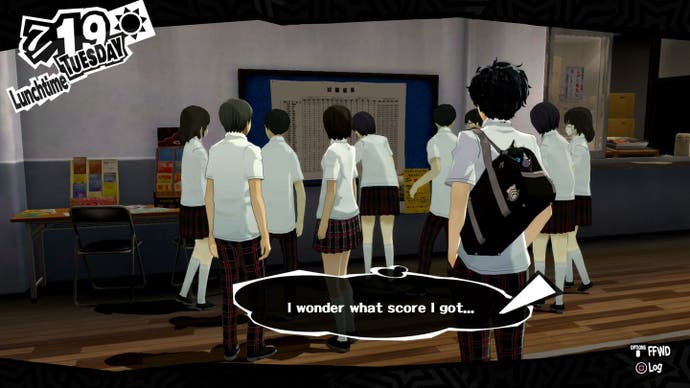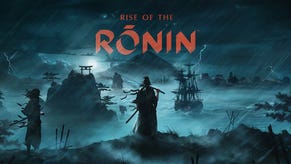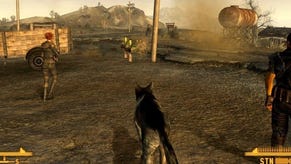Persona 5 - pytania i odpowiedzi do testów w szkole
Ściąga dla każdego.
Odpowiadanie na pytania w szkole to najbardziej realistyczna część gry Persona 5. Nauczyciele mogą niespodziewanie wezwać nas to odpowiedzi, a co kilka miesięcy jest także egzamin, testujący zgromadzoną wiedzę.
Niektóre pytania są całkiem proste, ale już inne wymagają znajomości japońskiej kultury czy historii i mogą sprawić spore trudności graczom z Polski. Aby nieco ułatwić życie, przygotowaliśmy kompletne zestawienie odpowiedzi.
Persona 5 - pytania i odpowiedzi
12 kwietnia:
Pytanie: A soul is composed of appetite, spirit, and what else?
Odpowiedź: Logic.
19 kwietnia:
Pytanie: Is the line extending from A connected to B or C? Which is it?
Odpowiedź: C.
23 kwietnia:
Pytanie: What event did Emperor Nero add to the Olympics so he could participate?
Odpowiedź: Singing.
25 kwietnia:
Pytanie: What's the common usage of kakushinhan again, regarding an action you take?
Odpowiedź: Knowing your actions are wrong.
Pytanie: But the real kakushinhan is the opposite, right? So the opposite means...
Odpowiedź: Conviction that you're right.
27 kwietnia:
Pytanie: How many colors does it take to paint every region without any two adjacent ones being the same color?
Odpowiedź: Four.
30 kwietnia:
Pytanie: First off, the „wunder” part probably means...
Odpowiedź: Wonder.
Pytanie: Next, the „kind” part. That's probably...
Odpowiedź: Child.
Pytanie: So a „wunderkind” would be...
Odpowiedź: A prodigy.
7 maja:
Pytanie: What do people generally call a woman who has a charm that sometimes leads men to their doom?
Odpowiedź: A femme fatale.
10 maja:
Pytanie: Who do you think is the origin of the term „magistrate's patronage”?
Odpowiedź: Minamoto no Yoshitsune.

Egzamin 11-13 maja:
- Pytanie: Although the line connects A to C it looks like it leads to B instead. What is this phenomenon called?
Odpowiedź: An optical illusion. - Pytanie: If how they're seeing things is different, it probably has to do with this sort of information...
Odpowiedź: Visual information. - Pytanie: What takes the visual information from your eyes and processes it is the, uh...
Odpowiedź: Brain. - Pytanie: The brain processes visual information. So, the reason why people see things differently is...
Odpowiedź: They have different cognitions. - Pytanie: Which of the following expressions came form the name of the position that Minamoto no Yoshitsune held?
Odpowiedź: Magistrate's patronage. - Pytanie: What is the origin of the English word „talent”?
Odpowiedź: The name of a sum of currency. - Pytanie: What did the Greek philosopher Socrates say that evil is born from?
Odpowiedź: Ignorance. - Pytanie: What's the least number of colors needed to paint Japan so no two adjacent areas are the same color?
Odpowiedź: Four.
16 maja:
Pytanie: Do you know who created the piece which sold for the highest price back in the 20th century?
Odpowiedź: Van Gogh.
21 maja:
Pytanie: What is the name of this ratio that Japanese architects and artists have liked using?
Odpowiedź: The silver ratio.
23 maja:
Pytanie: Well, your number's up. The root words of synesthesia are „syn” and „aisthesis”. What do they mean?
Odpowiedź: „Together” and „senses”.
26 maja:
Pytanie: What was the name of the other famous novel that Sherlock Holmes appeared in?
Odpowiedź: „Arsene Lupin, Gentleman Burglar”
30 maja:
Pytanie: Who was the pirate who said that he hid his treasure in a certain place just before he was executed?
Odpowiedź: William Kidd.
4 czerwca:
Pytanie: The original blazers were named that thanks to a certain quality they had. Any idea what it was?
Odpowiedź: They were brightly colored.
7 czerwca:
Pytanie: What are red king crabs most biologically related to?
Odpowiedź: Hermit crabs.
8 czerwca:
Pytanie: With the advent of the color TV, something else started appearing in color.
Odpowiedź: Do you know what it is? Dreams.
11 czerwca:
Pytanie: Can you imagine how much gold has been excavated by humanity over the course of history?
Odpowiedź: Three Olympic-sized pools.
13 czerwca:
Pytanie: Paper money is issued by the Bank of Japan, but who issues the coins?
Odpowiedź: The government.
15 czerwca:
Pytanie: What would happen if you keep washing your hair with water that's contaminated with metal?
Odpowiedź: It'll change color.
23 czerwca:
Pytanie: Who is this woman, drawn as the High Priestess in most tarot decks?
Odpowiedź: Pope Joan.
27 czerwca:
Pytanie: In English, what does the term „cat-and-dog weather” refer to?
Odpowiedź: Heavy rain.
28 czerwca:
Pytanie: This character is the cursive form of a specific kanji. Do you know which one it is?
Odpowiedź: Gold.
1 lipca:
Pytanie: ...But do you know what Chinese dish Zhuge Liang is credited for inventing?
Odpowiedź: Baozi.
4 lipca:
Pytanie: Do you know the reason why July and August both have thirty-one days?
Odpowiedź: Someone pretentious said so.

7 lipca:
Pytanie: What's the traditional food of Tanabata?
Odpowiedź: Soumen.
8 lipca:
Pytanie: What's a common trait of almost all shaved-ice syrups on the market?
Odpowiedź: They have the same flavor.
9 lipca:
Pytanie: What is the sum of angles a through e?
Odpowiedź: 180 degrees.
11 lipca:
Pytanie: What is the name of the light-producing substance in fireflies?
Odpowiedź: Luciferin.
12 lipca:
Pytanie: What was the name of the gentleman thief whose family was boiled alive during the Sengoku period?
Odpowiedź: Ishikawa Goemon.
Egzamin 13-15 lipca:
- Pytanie: Which of these phrases has its origins in this shogi piece?
Odpowiedź: Nouveau riche. - Pytanie: Goemon was popular because he wasn't just a thief, he was a...
Odpowiedź: Gentleman thief. - Pytanie: And the person in power who had it in for Goemon was...
Odpowiedź: Toyotomi Hideyoshi. - Pytanie: And, Gomeon's death after he got captured by Hideyoshi is famous too...
Odpowiedź: He was boiled alive. - Pytanie: Which of the following statements are true of this organism?
Odpowiedź: It's not related to crabs. - Pytanie: What is said to be the reason why people began dreaming in color?
Odpowiedź: Television. - Pytanie: Which of these was made using the silver ratio?
Odpowiedź: B4-size paper. - Pytanie: Define „syn” and „aisthesis,” the Greek root words of „synesthesia.”
Odpowiedź: „Together” and „senses.”
3 września:
Pytanie: In this famous statue, he's holding a spear in hist left hand, but what does he have in his right?
Odpowiedź: Nothing.
6 września:
Pytanie: What is the name of the phenomenon where the second hand looks like it stops moving?
Odpowiedź: Chronostasis.
14 września:
Pytanie: Second-hand shops are also known as thrift stores. Do you know when the earliest ones appeared?
Odpowiedź: The 19th Century.
17 września:
Pytanie: We have a saying in Japanese: a skilled hawk hides its talons. What hides its claws in English?
Odpowiedź: A cat.
21 września:
Pytanie: The word „robot” didn't come from English. So, what country did it come from?
Odpowiedź: Czechoslovakia.
24 września:
Pytanie: Do you know why they chose black and white?
Odpowiedź: So it shows up well on TV.
28 września:
Pytanie: So „PVS”, referring to when you mistakenly think your phone is going off... What's the P?
Odpowiedź: Phantom.
Pytanie: The next part is the V part. That means it'd be „phantom...” what?
Odpowiedź: Vibration.
Pytanie: Last is the S. So if we have „phantom vibration” so far... Odpowiedź: Syndrome.
29 września:
Pytanie: Not all civil servants work in government offices. Which of these occupations is a civil one?
Odpowiedź: Fishermen of Nagaragawa.
3 października:
Pytanie: ...but in the entire universe, which of these is closest to its density of stars?
Odpowiedź: Three watermelons in the sun.
6 października:
Pytanie: This device made mass executions possible. You know what it's called, yes?
Odpowiedź: A guillotine.
11 października:
Pytanie: Which do you think most people choose to name „kiki”?
Odpowiedź: A.
Egzamin 17-19 października:
- Pytanie: What is the origin of the word „guillotine”?
Odpowiedź: Name of the one who proposed it. - Pytanie: First of all, who proposed the idea of the guillotine?
Odpowiedź: A doctor. - Pytanie: So, from his perspective, what was the advantage of the guillotine?
Odpowiedź: It could execute people quickly. - Pytanie: Which of the following statements about this ball is true?
Odpowiedź: It has thirty-two faces. - Pytanie: What is the meaning of the word „robota”, the Czech word that is the root word of „robot”?
Odpowiedź: Slave labor. - Pytanie: What is the English name for the phenomenon where it feels like your cell phone is vibrating?
Odpowiedź: Phantom Vibration Syndrome. - Pytanie: Which of the following government organizations do the cormorant fishermen of Nagaragawa belong to?
Odpowiedź: The Imperial Household Agency.
22 października:
Pytanie: What number should be in the middle of this square to make it a magic square?
Odpowiedź: Five.
24 października:
Pytanie: Can you tell me what the S in SOS means?
Odpowiedź: It's meaningless.
2 listopada:
Pytanie: The word „wack” was also used in a coded language form history. What was that language?
Odpowiedź: Thieves' Cant.
4 listopada:
Pytanie: Clubs is a club, diamonds is a gem, spades is a sword... So, what is hearts?
Odpowiedź: The Holy Grail.
8 listopada:
Pytanie: Do you know what age you have to be in order to listen in on a trial?
Odpowiedź: Zero.
10 listopada:
Pytanie: Do you know what the line that's in „bird” but not in „crow” represents?
Odpowiedź: An eye.
12 listopada:
Pytanie: Do you know why hearing someone's voice over the phone sound different than their real voice?
Odpowiedź: It's heavily processed.
15 listopada:
Pytanie: When he was executed, something was doen to his appearance, Do you know what it was?
Odpowiedź: They put makeup on him.
17 listopada:
Pytanie: Which of these is called a cochleoid, after its resemblance to a snail?
Odpowiedź: B.
18 listopada:
Pytanie: At which of these location can you see the sunrise the earliest?
Odpowiedź: The summit of Mt. Fuji.
Egzamin 20-22 grudnia:
- Pytanie: Which of the following is called the Devil's curve?
Odpowiedź: D. - Pytanie: I think they said the voice you hear through the phone is...
Odpowiedź: Not their real voice. - Pytanie: But why does the listener think the synthetic voice is the real person?
Odpowiedź: They speak the same. - Pytanie: Even if the voice is different, as long as they talk the same, the listener will subconsciously...
Odpowiedź: Supplement the voice. - Pytanie: Which suit of cards represents the Holy Grail.
Odpowiedź: Hearts. - Pytanie: Which of the following is not true about the kanji for „crow”?
Odpowiedź: It includes a number. - Pytanie: Which country refers to a person who controls politics behind the scenes as a „prim minister in black”?
Odpowiedź: Japan. - Pytanie: What English word did the initial „do” in the Japanese „dokyuu”, or massive, originate from?
Odpowiedź: Dreadnought.















